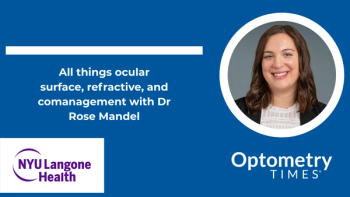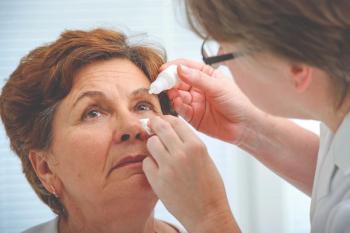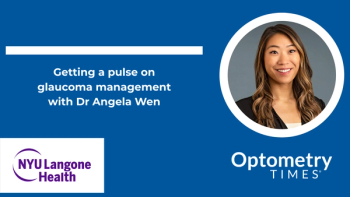
An OD’s experience with online contact lens disruptors
Unless you have been avoiding the Internet at all costs, you have likely seen an abundance of ads for new
We sat down with Ryan Corte, OD, who practices in the growing metropolitan city of Charlotte, NC, to learn more about why patients are increasingly interested in subscription contact lens services and how ODs can best discuss the topic with patients at their yearly eye exam.
In addition to practicing optometry and being a new dad, Dr. Corte is the founder of
Knowing patients were seeking more information about online contact lens subscription services, he decided to sign up as a patient for four of the most popular online disruptors on the market: Hubble, Waldo, Sight Supply, and Aveo.
The investigative journey led to him to not only learn more about the marketing behind each company and the process patients experience when using a subscription service, but he created a
The disruptors
Dr. Corte ordered contact lenses from four of the most popular online contact lens subscription companies. Three are based in the United States; Waldo is based in the UK.
The first disruptor to market for online contact lens subscription is also the most well-known. Dr. Corte says that a few of his patients have asked him about online subscription contact lenses, and all of the those that have specifically asked him about Hubble.
Material: Methafilcon A
Manufactured in: Taiwan
This UK-based subscription service was founded by Harvard graduate Ashleigh Hinde.
Material: Etafilcon A
Manufactured in: Taiwan
This company offers both spherical and toric daily disposable lenses as well as FreshRx, the company’s own contact lens prescription renewal service.
Material: Omafilcon A
Manufactured in: Malaysia
This company has teamed up with newly rebranded
Material: Etafilcon A
Manufactured in: Taiwan
Obtaining lenses
To research his review video, Dr. Corte ordered lenses from all four of the above online contact lens disruptors with the goals of becoming better informed about the patient experience and providing information so patients could make an informed decision before signing up for such subscription services.
Dr. Corte noted common themes in the marketing messages of the four companies. Of note, all of the companies are founded not by optometrists but by contact lens-wearing patients with marketing and business backgrounds who saw opportunity to disrupt the healthcare system.
The language used in branding and marketing for each company is very patient-focused, avoiding a discussion of the technical aspects of contact lens design or oxygen transmission and focusing on consumer-friendly language about convenience and price.
Ocular health is mentioned as a selling point of why daily disposable contact lenses are the model of choice for each of these services (a conversation that many patients will recognize from their last visit with their eye doctor because many ODs have embraced a similar message about daily disposable contact lenses and their benefits of reduced risks for eye infections over the last decade).
Of interest is that in the fine print of the contact lens packaging and the FAQ sections of each company’s website, you will see statements pointing consumers to see their doctor if they are having problems with their contact lenses. Contact lens doesn’t fit right? Wake up with a red eye? Not a manufacturer problem; you should see your doctor.
Another takeaway from Dr. Corte’s research was that the Federal Trade Commission’s (FTC) Contact Lens Rule is very loosely enforced. The Contact Lens Rule requires that anyone selling contact lenses must contact the prescriber via direct communication or facsimile, and the prescriber must be given 8 hours to respond during their normal active business hours.
For three out of the four companies that Dr. Corte signed up for as a patient, he never received prescription verification at his office. The one company that did send a verification did so via an email sent over the weekend, outside of his office’s business hours, leaving him no time to reply before the prescription was filled.
What can we learn?
In addition to better understanding his patients’ experience as contact lens consumers, Dr. Corte gained valuable information about how these companies successfully market to and attract patients. He plans to use this information in the exam room.
Shipping contact lenses to a patient? What would you rather receive: a basic cardboard box or a sleek package with attractive colors and branding? Research has shown that the psychology of opening a box is a key draw for why subscription box services are successful-receiving those monthly boxes activates the reward and pleasure-seeking centers of the brain in the substantia nigra and ventral tegmental area.1
Dr. Corte encourages ODs to think about branding and marketing to their patients. Focus on the patient’s experience. Looking at contact lens education specifically, Dr. Corte makes sure he spends time educating patients on why he prescribes a certain contact lens brand and material. He presents new technology to patients at each annual visit, even to patients who report they are happy with their current contact lenses.
He cautions providers not to assume that patients are wearing the lenses ODs prescribed at the previous visit. A great way to start the conversation without causing uncomfortable confrontation? “Last year we prescribed XX brand contact lenses. What’s been your experience?” It’s an invitation for patients to share their real lens experience and get discussions going about how you can help make improvements.
Answering patient questions
What if a patient asks you about an online contact lens disruptor? If a patient is asking your opinion, that means he values and trusts your insights. This is a great sign that you are fostering relationships with your patients that will keep them coming back.
How should you answer your patients’ inquiries? Dr. Corte encourages doctors to focus on the technology differences and the value you provide as their doctor.
“Tell patients the disruptor is a new start-up company, but the contact lenses are designed with outdated technology,” he says. “You offer superior products for the same price or better. Your lenses can keep them wearing their contact lenses longer and more comfortably and keep them seeing better.”
Even if patients try the inferior contact lens disruptor product this year, Dr. Corte predicts those patients will be back seeking your care and advice if they have been educated about the differences.
References:
1. Cell Press. Pure Novelty Spurs The Brain. ScienceDaily. Available at: www.sciencedaily.com/releases/2006/08/060826180547.htm. Accessed 3/18/19.
Newsletter
Want more insights like this? Subscribe to Optometry Times and get clinical pearls and practice tips delivered straight to your inbox.



















































.png)


